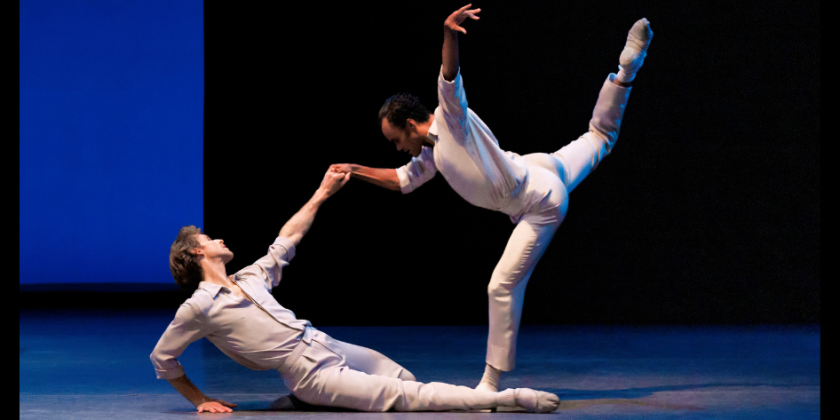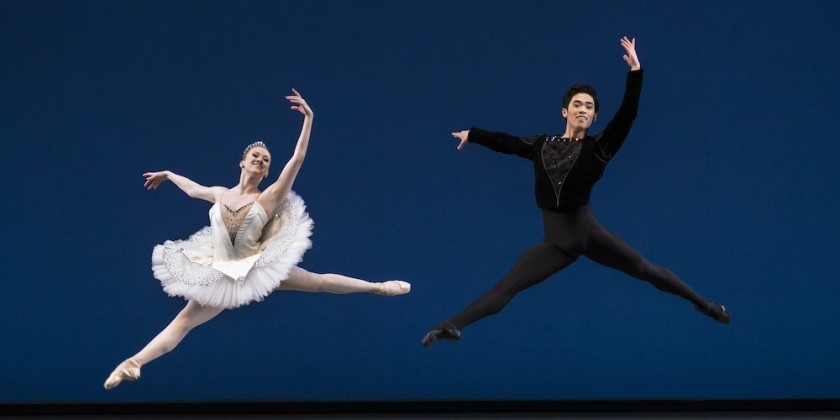IMPRESSIONS: New York City Ballet's 75th Season “The Future” at Lincoln Center

Dances at a Gathering
Music: Frédéric Chopin
Choreography: Jerome Robbins
Pianists: Susan Walters (April 26) and Hanna Hyunjung Kim (April 27)
Brahms-Schoenberg Quartet
Music: Johannes Brahms, Orchestration: Arnold Schoenberg
Choreography: George Balanchine)
Conductor: Andrew Litton
Dancers of the New York City Ballet: View biographies
Performance Dates: Friday, April 26 and Saturday afternoon, April 27, 2024
Choreographer Jerome Robbins dedicated his masterpiece Dances at a Gathering to lighting designer Jean Rosenthal, who had passed on three weeks before the work’s premiere in May 1969. The beauty of Dances… set to a selection of composer Frédéric Chopin’s mazurkas, études, waltzes, a scherzo, and a nocturne played by a solo pianist, might be an homage to light itself. Different scenes and groupings shed light on the individuals who experience an arcadian day. This lovely community of ten gorgeous people has a youthful innocence as well as a sense of adventure.
Robbins’ innate sense of (or obsession with?) form gives this wreath of incidental dances a backbone. He assigns the opening mazurka, op.63, no.3, (in C minor) to a single man. Then he has one couple waltz, and another pair dance a mazurka in C major. The next solo goes to a woman. Thus, the first four dances form a 1-2-2-1 mirroring symmetry in which the music wakes up and gets ultimately brighter. Megan Fairchild (on Friday) and Olivia MacKinnon (on Saturday afternoon) spread joy. According to the program, they are clad in an apricot dress (yellow, say I). The day seems full of promise.
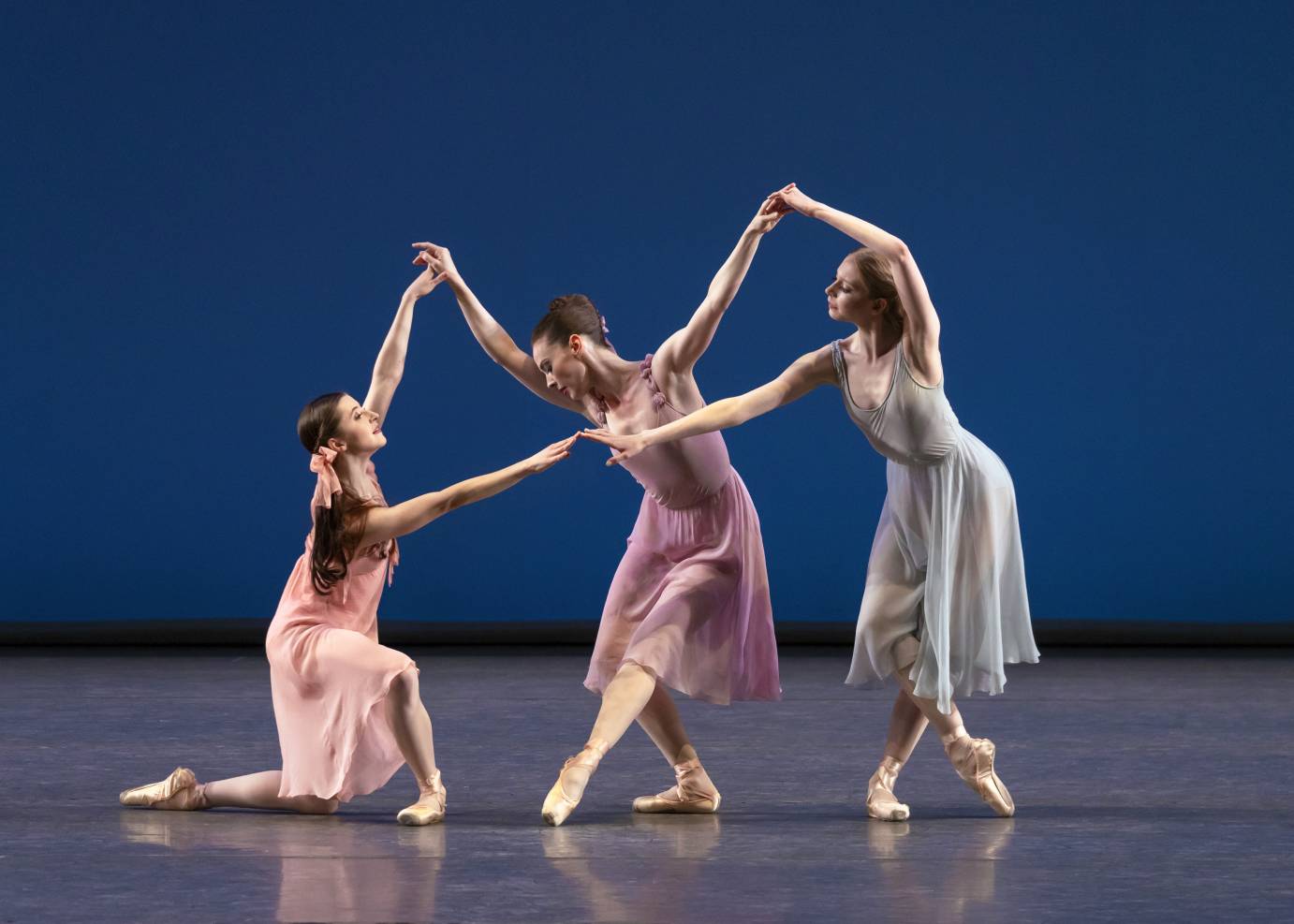
The man who follows her finishes his short segment interacting briefly with another man, who in turn dances with two ladies before these two partner with three men. The uneven totals grow: 1+2=3, and 2+3=5. After lively prancing, Robbins ingeniously introduces tableaux as a morning respite. They offer a break from the action, a breath between a day’s dances. Only then do the five dancers form couples; and it appears that the man in green might be left without a partner. At the very last moment, however, the woman in mauve runs in to join him. 5+1=6. In Dances …, the population grows gradually, and its world is round and balanced.
Another interesting facet about Dances … is the shift of focus throughout the performance. While some segments are playful social interactions, at other times the dancers seem lost in reverie. Adrian Danchig-Waring (in green) must have given projection vs. introspection a lot of thought. Here he often lives in the moment, almost giving the impression of fluid improvisation were it not for the perfect execution of his steps. Danchig-Waring’s dedication - not only to the material, but also to the spirit of the work - move me deeply during Friday’s performance; and it is to the credit of Aaron Sanz that I am able to enjoy his interpretation on Saturday afternoon as well.
Friday evening’s energy is especially charged. Mira Nadon (in green) steps in for another dancer. Her solo comes late in the dance. She is the odd one out in many ways. While she only appears in one of the two dances the woman in green usually performs, she has the audience spellbound after just a few barres of music. Although one barely gets a glimpse of Nadon, her artistry is evident. Fairchild is the valiant trouper who picks up the extra work of strolling with ever-changing partners in style.
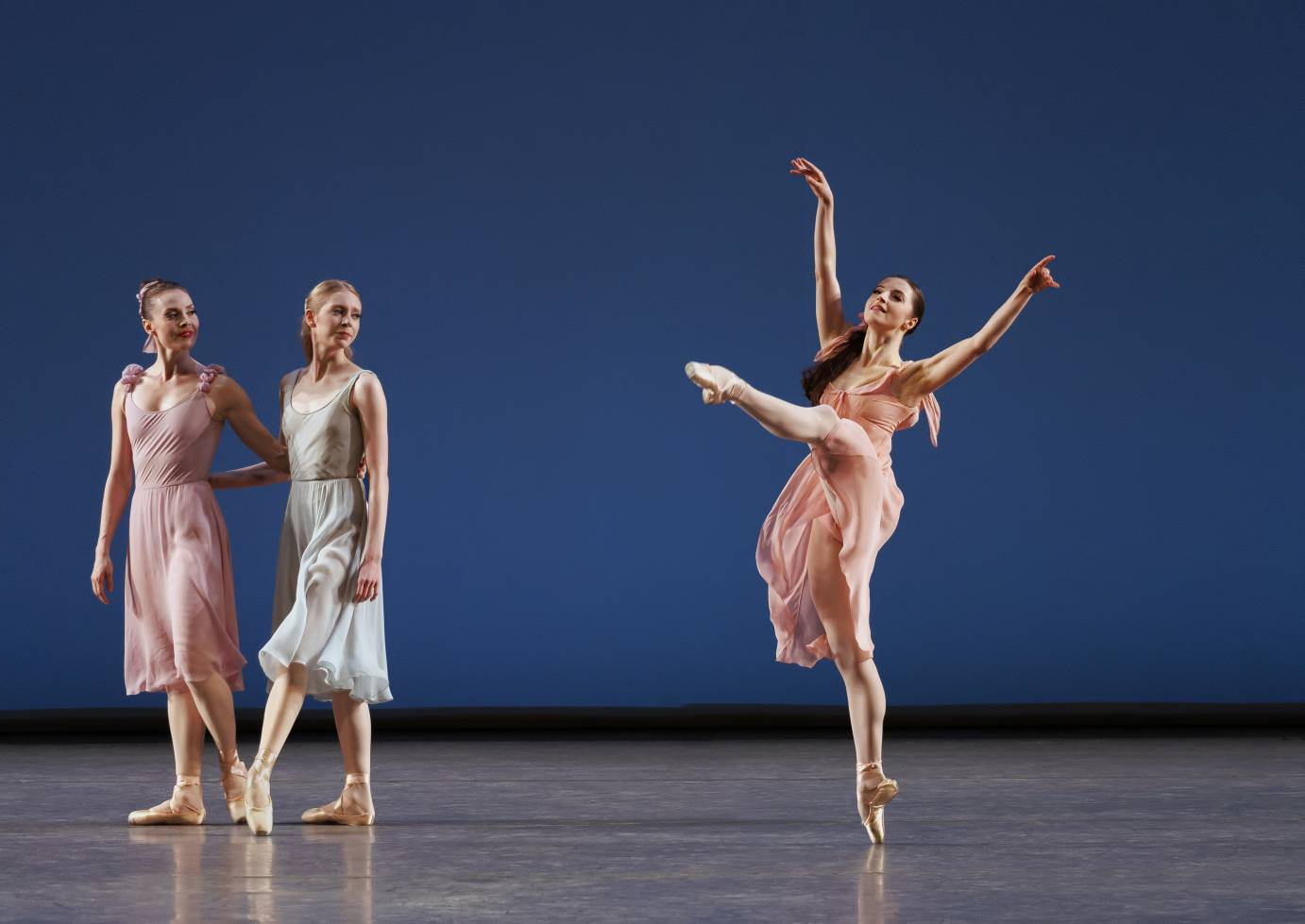
Indiana Woodward with Emilie Gerrity and Dominika Afanasenkov in Jerome Robbins’ Dances at a Gathering. Photo credit: Erin Baiano
But all of Friday’s cast members seem alert. From the outset of the piece, effulgent Roman Mejia (in brown) underscores changes in mood with wonderful clarity. In the waltz following Mejia’s opening solo, Unity Phelan (in mauve) dances with Danchig-Waring, while Tiler Peck (in pink) dances with Tyler Angle (in purple) in the C-Major mazurka; all four showing their mastery of musical partnering that seems to happen effortlessly. Andres Zuniga (in brick) is a sunny addition to the cast; and Alston MacGill and Harrison Coll (both in blue) contribute their respective glow. Carried by Susan Walters piano playing, Friday’s performance still resonates.
Saturday afternoon’s performance is less mature, and the partnering generally not as assured. This unpredictability adds an element of surprise and excitement. MacKinnon and Sanz are joined by Indiana Woodward (in pink), Emilie Gerrity (in mauve), Dominika Afanasenkov (in blue), a fine Anthony Huxley (in brown), Chun Wai Chan (in purple), Victor Abreu (in brick), and David Riccardo (in blue). Ashley Bouder — as this cast’s latecomer in green - convinces with broad charm and a fervid rendition of the choreography. Hanna Hyunjung Kim is the pianist.
One of the many layers that make me love Dances… is its sense of community. The work is as non-hierarchical as ballet was able to get at Lincoln Center in 1969. Student riots of the time reformed societies around the globe. As lovely and unassuming as the work seems, its world of equals was new to the classical ballet realm and brought democracy to the imperialist-corporate structure of Lincoln Center and its resident ballet company. Yes, Tudor and de Mille had introduced theme-based communal ballets decades earlier; and Robbins himself had done jazz-infused group work. Robert Joffrey’s Astarte had just rocked US-American ballet a year and a half earlier. Still, I contend that within the strict aesthetic of classical ballet - particularly at Lincoln Center — it took Dances… to introduce an atmospheric abstractionism that was American in its community spirit, and make it acceptable.
The curtain descends as couples are about to walk off-stage after having formed a final circle. The execution of the choreography was not always perfect on Saturday afternoon, yet Dances at a Gathering still shines as a beacon of an ideal society
Next, the program presents another take on romanticism: Balanchine’s Brahms-Schoenberg Quartet. A few seasons ago, I analyzed the work at length.
The beauty of "Brahms’ Piano Quartet in G minor, Op. 25", orchestrated by Schoenberg, is a deeply satisfying progression in harmony and volume. I treasure the New York City Ballet Orchestra, here under the baton of music director Andrew Litton.
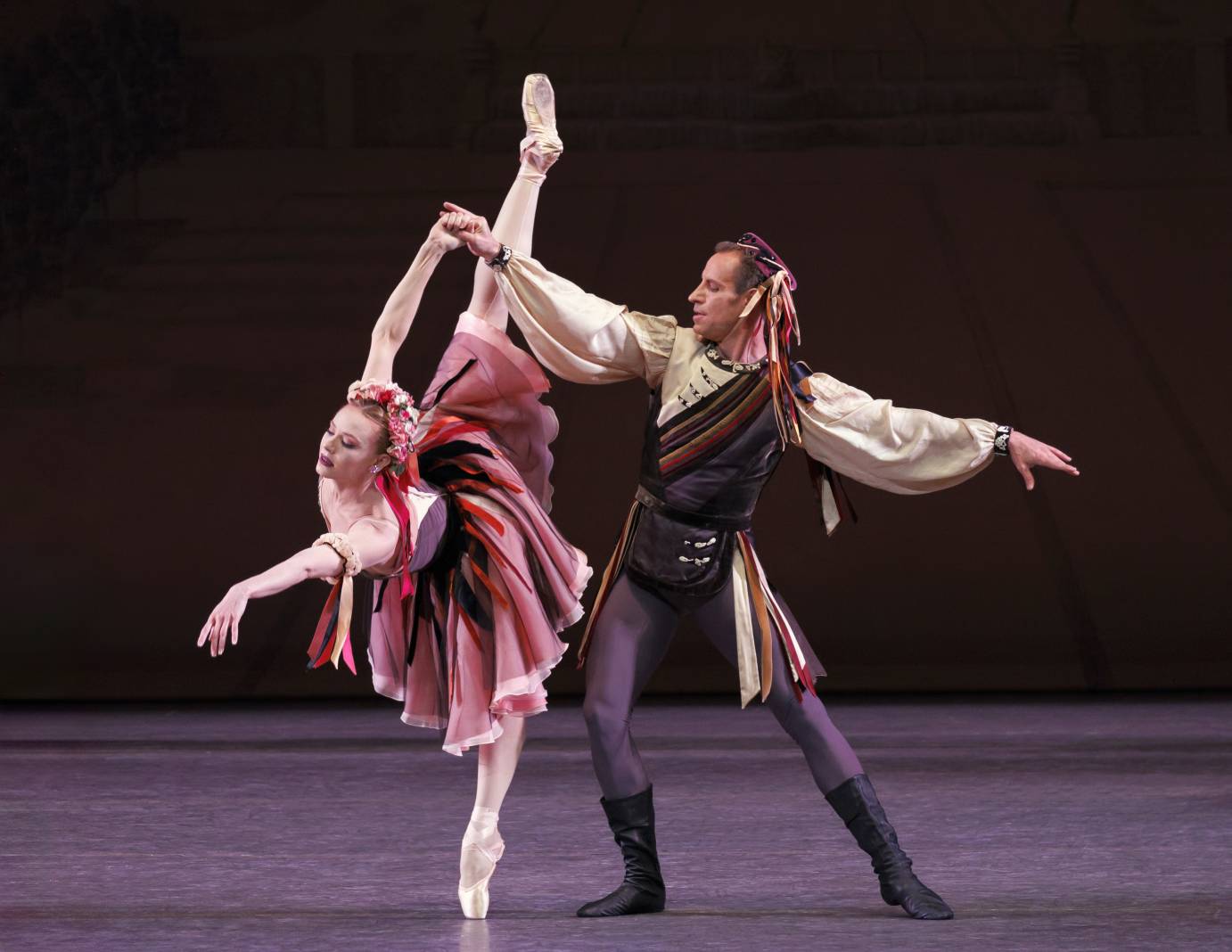
Sara Mearns and Andrew Veyette in George Balanchine’s Brahms-Schoenberg Quartet. Photo: Erin Baiano
The dancing in these performances does not always convince, however. On Friday, Emily Kikta as the soloist in the opening “Allegro” owns the space, but Emilie Gerrity and Taylor Stanley look like tenants who can’t afford the rent. In the “Intermezzo,” Preston Chamblee haphazardly maneuvers Olivia MacKinnon (who replaces an injured dancer). Am I watching a twelve-tone, or a twelve-step desecration here? Emma von Enck and Anthony Huxley restore my faith in the beauty of ballet in the work’s “Andante.” They both attack and play with phrasing; they take risks; they trust one another. I cheer. Sara Mearns and Andrew Veyette have fun as fiery gypsies in the closing “Rondo alla Zingarese.”
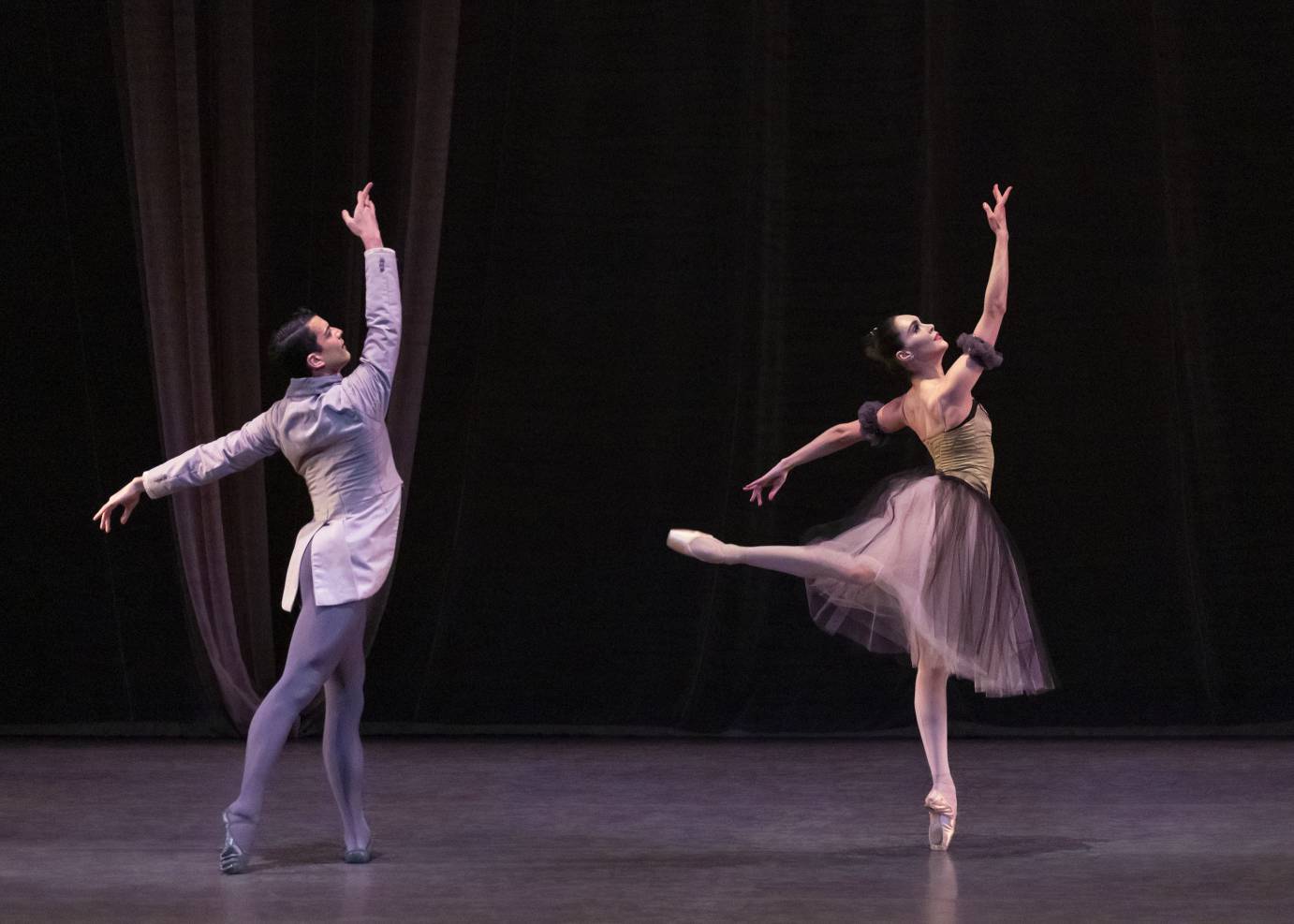
Mira Nadon and Gilbert Bolden III in George Balanchine’s Brahms-Schoenberg Quartet. Photo: Erin Baiano
On Saturday afternoon, Miriam Miller inhabits Schönbrunn Palace; and Alexa Maxwell and Peter Walker make a good case that they belong there, too. Walker works hard. In the best of all possible worlds, one would not notice his exhaustion by the end of the “Allegro,” but I don’t mind. He dances well and, more importantly, supports Maxwell with detailed attention.
Mira Nadon and Gilbert Bolden III ennoble one another and reward the audience with an impassioned “Intermezzo.” The most intricate partnering move, an almost horizontal flip in his arms aided by one foot crossing the other pushing off the ground to gain circular momentum, looks not only seamless, but inspired. Nadon and Bolden offer deep dips, high lifts, and fully committed, grand-scale dancing on melodic waves, relishing each and every moment. They leave no crumbs behind.
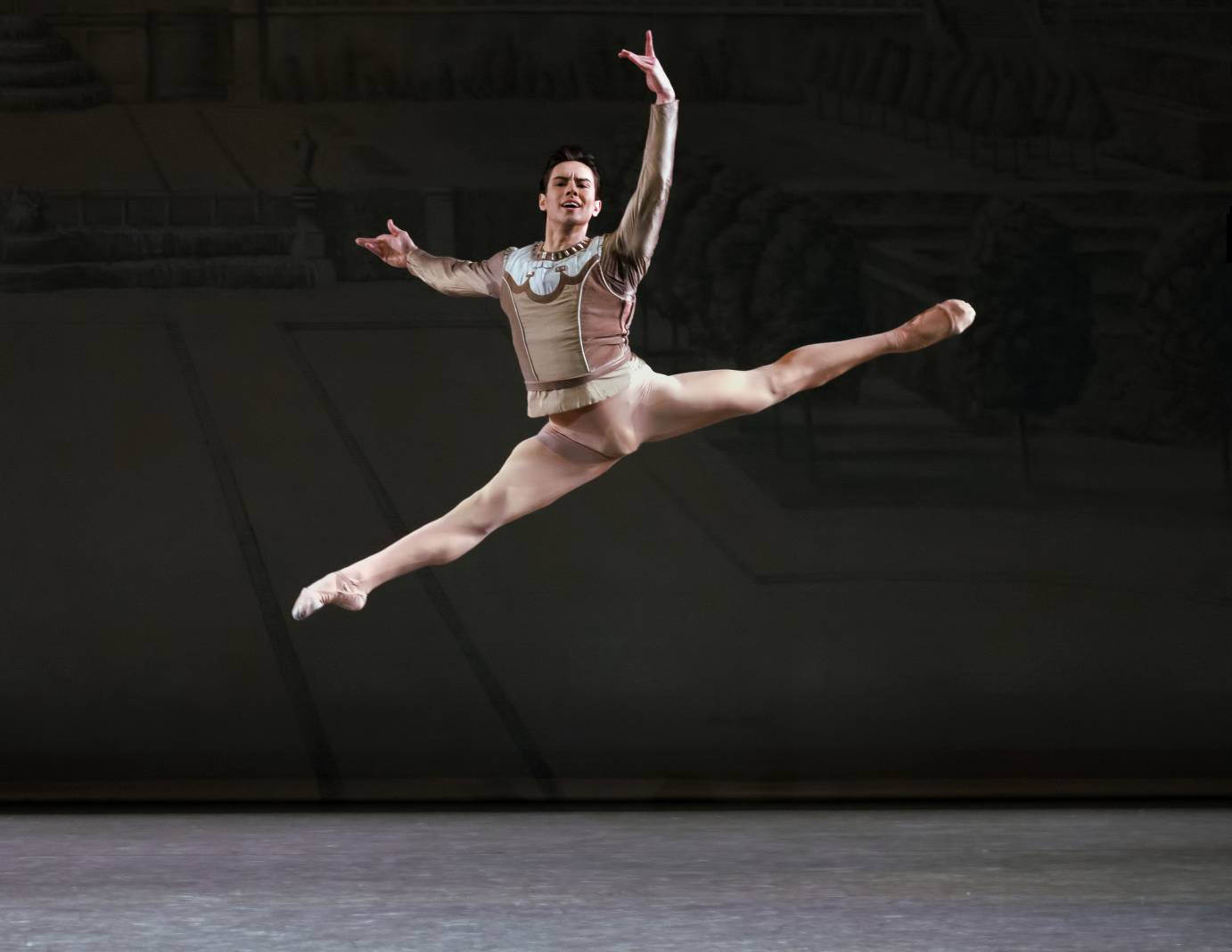
Roman Mejia in George Balanchine’s Brahms-Schoenberg Quartet. Photo: Erin Baiano
Megan Fairchild and Roman Mejia dance the “Andante;” and in the “Rondo alla Zingarese,” Unity Phelan infuses her gypsy vamp with a touch of aristocracy supported by Tyler Angle. It’s still enjoyable, although I prefer a more daredevil approach.
Brahms-Schoenberg Quartet is one of many Balanchine works well worth keeping in the repertoire. That I shed tears at both performances of the “Intermezzo,” for very different reasons, speaks to the unpredictable nature of live performance. While questioning some of the casting choices, I applaud the company administration for programming these masterpieces.










